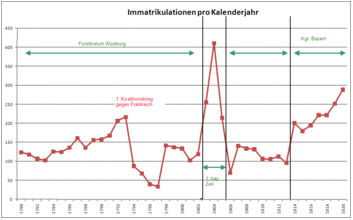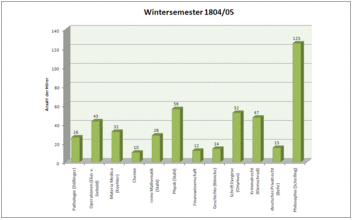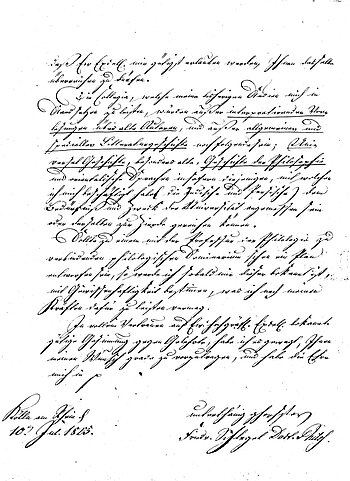First Bavarian time
University Reform and Intellectual Awakening: The First Bavarian Period (1802 - 1805)
The end of 1805 marked the end of the first Bavarian phase for the University of Würzburg, which had brought the university an unimagined upswing, but had also placed a heavy burden on it for the future.
This development was embedded in the larger context of the upheavals in Europe brought about by Napoleon. After Austria's defeat in the Second Coalition War against Bonaparte, Emperor Franz II had been forced to recognize France's annexation of the territory on the left bank of the Rhine in the Peace of Lunéville (1801). Under pressure from the later Emperor Napoleon, the German middle states affected by this, which were to serve as a buffer between Austria and France, were compensated and bound to France by the dissolution of the ecclesiastical principalities and estates as well as by smaller territories that were independent of the empire (secularization and mediatization). The final dissolution of the Old Empire had begun. The Electorate of Bavaria received, among other things, the former prince-bishopric of Bamberg as well as the diocese of Würzburg, which was taken possession of by Bavarian troops at the end of 1802.
For the Julius University, this marked the end of the sheltered, albeit intellectually narrow and provincial time under the prince-bishops. The fact that the bishops supported the university until the end of their reign is shown by the incorporation of the Jesuit fund into the university fund in February 1802 - as a farewell gift, so to speak - which strengthened the university's financial resources not inconsiderably. Nevertheless, it remained uncertain for almost a year whether the University of Würzburg or the University of Bamberg would continue to exist, since there was to be only one other Bavarian state university in addition to the one that had been transferred from Ingolstadt to Landshut in 1802 (and to Munich in 1826). The favorable financial situation played an important role in the decision in favor of Würzburg, but also the advantageous location, which was to make the university the mediator between northern and southern Germany. The previously necessary fundamental reformation of the new state university entitled the Bavarian Elector Maximilian IV. Joseph next to Julius Echter von Mespelbrunn in the name of the university.
The leading North German universities served as models for the reform. The university lost its confessional character; from now on, Catholics and Protestants had equal rights. Following the Göttingen model, a curatorship was established under the direction of the General Commissioner for the Principalities in Franconia, Count Thürheim, who, as an authority between the ministry and the university, had to make all local decisions and implement the reforms of Max Joseph and Montgelas. University self-administration was severely curtailed, the four faculties were replaced by two classes of four sections each, the rectorate and the senate were largely disempowered (the curate was able to exert a decisive influence on the outcome of the election of the prorector), and the university's own jurisdiction was gradually reduced to disciplinary supervision. While this increasing state paternalism was extremely unpopular at the university, the university nevertheless experienced an unimagined upswing, not least because of the generous appointment policy. The University of Würzburg was to be able to compete with any other university and to take on a model character as a mediator between the intellectual and cultural forces of the German north and south. Old professors, perceived as backward, were retired and numerous new, mostly northern German Protestant, scholars were appointed.
The appointment in 1803 of the 28-year-old philosopher Friedrich Joseph Schelling, one of the main representatives of German idealism, who was to represent the new spirit as a striking figurehead and attract numerous other scholars and students to Würzburg, was of central importance here. With the numerous new appointments (in addition to Schelling, Heinrich Eberhard Gottlob Paulus, Friedrich Philipp Immanuel Niethammer and Gottlieb Hufeland) and the simultaneous doubling of professors' salaries, and the building needs that followed the upswing of the university (establishment of new auditoriums, living quarters for the professors in the Old University), no consideration was given to the financial possibilities of the university, which was endowed with rich assets, and this was to lead to fatal indebtedness.
Schelling, who immediately became a member of the 9-member senate after his appointment, soon made trouble in Würzburg with his manner; Count Thürheim already complained in 1804 about the arrogance of Schelling, who was so favored by him. However, he completely fulfilled his purpose of serving as a magnet for students. This is evident when one considers the attendance at his lectures. It should be noted here that at the beginning of the 19th century, the mass university that characterizes our image of universities today did not yet exist. While the University of Würzburg had 550 students in 1803, there were already 730 students in 1804/05, which was more than at the University of Tübingen, for example.
If one converts the proportion of students attending Schelling's lectures to today's proportions, a lecture at a university like Würzburg with 18200 students would have to be heard by just under 3100 students to achieve the same appeal as Schelling's lectures.
This new brilliance of the University of Würzburg began to shine so brightly that even the philosopher and important representative of early Romanticism, Friedrich Schlegel, applied for a professorship of philology in Würzburg on July 10, 1805 (University Archives ARS 1589). The senate, however, had doubts about his ability as a teacher and spoke out against an appointment.
With the Peace of Pressburg in 1805, the first Bavarian phase in Würzburg ended in January 1806; in the course of the Napoleonic transformation, the land came to Archduke Ferdinand of Austria, the former Grand Duke of Tuscany or Elector of Salzburg, until 1814. As part of the subsequent re-Catholicization of the university, most of the newly appointed scholars left Würzburg for Munich. The University of Würzburg sank into a provincial twilight sleep until the end of the Napoleonic Wars.
Author: Marcus Holtz









